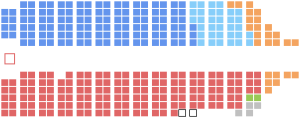Parliament of Canada Parlement du Canada | |
|---|---|
| 44th Parliament | |
 | |
| Type | |
| Type | |
| Houses | Senate House of Commons |
| History | |
| Founded | 1 July 1867 |
| Preceded by | Initially assumed some jurisdiction from:
Later added some jurisdiction from: |
| Leadership | |
Charles III since 8 September 2022 | |
Mary Simon since 26 July 2021 | |
| Structure | |
| Seats | 443 338 Members of Parliament 105 senators |
 | |
Senate political groups |
Conservative (15)
Non-affiliated (10)
Vacant (10) |
 | |
House of Commons political groups | His Majesty's Government
His Majesty's Loyal Opposition
Parties without official status
|
| Elections | |
| Appointment by the governor general on advice of the prime minister | |
| First-past-the-post | |
Last House of Commons election | 20 September 2021 |
| Meeting place | |
 | |
| House of Commons of Canada – West Block – Parliament Hill Ottawa, Ontario Canada and Senate of Canada – Senate of Canada Building 2 Rideau Street Ottawa, Ontario Canada | |
| Website | |
| parl | |
The Parliament of Canada (French: Parlement du Canada) is the federal legislature of Canada, seated at Parliament Hill in Ottawa, and is composed of three parts: the King, the Senate, and the House of Commons.[2] By constitutional convention, the House of Commons is dominant, with the Senate rarely opposing its will. The Senate reviews legislation from a less partisan standpoint and may initiate certain bills. The monarch or his representative, normally the governor general, provides royal assent to make bills into law.
The governor general, on behalf of the monarch, summons and appoints the 105 senators on the advice of the prime minister, while each of the 338 members of the House of Commons – called members of Parliament (MPs) – represents an electoral district, commonly referred to as a riding, and are elected by Canadian voters residing in the riding. The governor general also summons and calls together the House of Commons, and may prorogue or dissolve Parliament, in order to either end a parliamentary session or call a general election. The governor general also delivers the Throne Speech at the opening of each new Parliament (the monarch occasionally has done so, instead of the governor general, when visiting Canada).
The current Parliament, summoned by Governor General Mary Simon in November 2021, is the 44th Parliament since Confederation in 1867. The official languages of the Parliament are English and French.[3]
- ^ Honderich, Holly. "Canada's NDP pulls support for Trudeau's Liberals". bbc.com. British Broadcasting Corporation. Retrieved 4 September 2024.
- ^ Constitution Act, 1867, s. 17.
- ^ Canadian Charter of Rights and Freedoms,s. 16(1).